Today when you go to the grocery store, you can almost always count on certain items being available: apples, oranges, lemons, bananas, and berries, as well as vegetables like spinach, carrots, potatoes, and many more.
Because of this, it’s easy to forget that fruits and vegetables each have their own season, and are not grown year-round. It can be, however, quite noticeable that a fruit is out of season when you eat it, and a strawberry in January tastes very different than a strawberry in June.
Aside from a vastly better flavor, there are many other benefits to eating fruits and vegetables according to their season.
Buying In-Season will Save You Money
When a fruit or vegetable is in season, there is a much more abundant crop available. Basic economics says that when there’s more of a product available, the price will be lower, and when there’s less of a product available, the price will be higher because there is greater demand.
This holds true for produce. For example, a grapefruit will be much cheaper in December when it is in season, because there is an abundance of that crop, and much more expensive in June when they’re harder to come by.
By contrast, a strawberry will be significantly more expensive in December, and much cheaper in June, when it is in season.
If you’re trying to keep your grocery budget low, consider following the seasons when you’re at the supermarket to avoid paying four times the price for out-of-season produce [1].

Buying In-Season is More Nutritious
Plants get their nourishment from the sun and soil, so when that changes, so do their nutrients. This change in nutritional quality is reflected in the taste, so when you bite into a strawberry that is bland and tasteless, that strawberry is also not supplying you with the same nutritional value as it should [2].
One of the most important health benefits to eating in-season is that it supports your gut microbiome. You have an abundance of good bacteria that live in your stomach and your digestive tract that are constantly changing throughout the year. Different produce throughout the year offer different benefits to those bacteria and provide them what they need at the time they need it.
For example, the fruits we eat in the summer tend to be higher in fructose. As we enter the fall, however, produce that comes into season tends to be higher in resistant starch. As the weather gets cooler, we tend to become more sedentary, so it is better to limit high-fructose fruits to prevent a yeast overgrowth that could lead to bloating, moodiness, and skin changes [2].
Part of the reason for this is because often produce that is sold to us out of season is travelling a great distance to get to our grocery store shelves. This means that it must be picked before it has reached full ripeness so that it is not overripe by the time it arrives at its end destination.
Once a fruit or vegetable is removed from its source (such as a tree or a bush), it no longer receives the same amount of nutrients. Nutritional value can also be lost in transportation, because it often has to be scanned with radiation to kill germs, or may not be stored in optimal conditions while it is travelling [1].
For this reason, not only is it better to eat in season, but eating locally will also improve the nutritional quality of the food you buy, since the fewer miles your food travels, the less potential there is for nutrient loss [2].

Buying In-Season Offers More Variety
This goes hand-in-hand with an improved nutritional value, simply because the greater variety of fruits and vegetables that you eat, the greater the variety of nutrients you will get in your diet.
Eating in-season forces you to change which produce you are eating throughout the year, which automatically increases the variety in your diet. Not only does this offer health benefits, but it can make your diet more exciting, since it affords you the chance to get excited about different fruits and vegetables whenever they come into season [1].
Buying In-Season is Better for the Environment
Growing and eating food has an impact on the environment. Eating according to the seasons, however, can reduce that impact and make our communities more environmentally sustainable. There are two different ways to define seasonality within the context of sustainability:
- Globally Seasonal – food that is grown in the natural production season but is sold and consumed anywhere in the world.
- Locally Seasonal – food that is grown in the natural production season but is sold within the same climatic zone.
When you buy produce that is globally seasonal (for example, if you buy oranges in-season when you live in the North East) you receive the nutritional benefits of having access to a changing variety of fresh produce year-round. An increased global demand, however, has a higher environmental cost for the country of origin, such as an increased demand for water, or changes in land use that lead to a loss of biodiversity.
Eating locally is often described as being more environmentally sustainable because since the food does not have to travel as far, it produces less greenhouse gas emissions. Locally seasonal food does not necessarily produce less greenhouse gasses than globally seasonal food overall, because the amount of emissions depends more on the production system than transportation [3].
That being said, food grown in-season tends to require less energy input (since it does not need to be grown in a greenhouse), less water, and less chemical fertilizers and pesticides, which does have environmental benefits.
Additionally, local farms that are smaller, family-run operations tend to use more sustainable methods of farming that contribute to biodiversity and protect the environment, making them a better option for the environmentally-conscious shopper.
Read: Paris Is Building the World’s Largest Organic Rooftop Farm
Buying In-Season is Better for the Local Economy
Buying in-season often means shopping at your local farmer’s market or purchasing food that was grown in your region. When you support the farmers in your area, you are putting your money back into your community and directly benefiting the local economy [2].
Seasonality Depends on Where You Live
In our global economy, we are able to purchase a variety of fruits and vegetables from around the world that we would not otherwise have access to. Someone living in upstate New York can go to the grocery store and get mangos from South Asia, avocados from Mexico, and oranges from California.
This, again, is referred to as “globally seasonal”- avocados will never be in-season in New York, but you can purchase them from somewhere else when they are in-season in their country of origin.
When you are considering seasonality at a more local level, however, things change in terms of what is available depending on where you live. Summers in New York are abundant in seasonal fruits and vegetables, from asparagus in the spring, to cherries in July, to apples in the Fall.
If you live on the opposite side of the country, perhaps in California, you will likely get to enjoy a longer growing season for many fruits and vegetables because the climate there is warmer and more conducive to certain crops.
If you are trying to eat according to what is seasonal in your area, check out this interactive map that you can adjust according to region and season.
Keep Reading: Want to double world food production? Return the land to small farmers.
A Guide to Seasonal Fruits and Vegetables
Eating seasonally doesn’t mean that you have to give up some of your favorite fruits like mangoes and oranges if you don’t live in regions that produce them. Again, it’s important to make the distinction between global and local seasonality.
While eating locally does provide a lot of benefits, if you are buying produce that is grown in another part of the world, buying it when it is in-season will still be better than when it’s not.
Check out this handy chart below that tells you when many fruits and vegetables are in-season around the world. You can also check out the SNAP-Ed Connection on the USDA Website.


